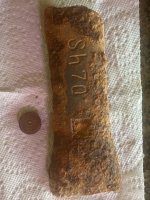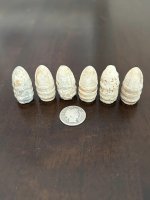kenb
Bronze Member
Crashed Spitfire is back from dead
Oct 8 2007 by Liam Murphy, Liverpool Echo
A WARTIME Spitfire which crashed in a Merseyside park 65 years ago was excavated this weekend.
History experts and enthusiasts have dug up parts of the plane which locals said caused “quite a bang” when it plummeted from the Wirral skies on October 14 1942.
About a quarter of the aircraft, including its complete Rolls-Royce Merlin engine, all the cockpit instrumentation, part of the pilot’s seat and the remains of the pilot’s sunglasses have been recovered from an 18ft-deep hole in Birkenhead Park.
Among those watching the excavation was Arthur Aspey, one of the few remaining eye-witnesses to the crash, which the pilot survived.
Mr Aspey was a 13-year-old schoolboy playing in the park when he heard the plane’s engine and looked up to see it plunge “nose down into the ground”.
“ I saw it coming down and there was a bang.”
Mr Aspey, 78-year-old retired electrician, lived close to the park.
“I was told that at the girls’ school nearby, one of the teachers thought it was a bomb and ordered all the children under their desks.”
An icon of the RAF, the Spitfire’s famous silhouette, with smooth contoured lines and oval wings, helped to lodge it firmly in the public mind as the most instantly recognisable aircraft of World War II.
It is understood the pilot of the Birkenhead Park Spitfire, Sgt Goudie of the Royal Canadian Air Force, bailed out after experiencing engine trouble.
He believed he had aimed the aircraft at the Mersey but it carried on farther than expected, luckily crashing into the park rather than surrounding buildings.
The pilot landed on Liverpool maternity hospital roof.
The excavation was the culmination of two years’ planning by the Warplane Wreck Investigation Group, which has a museum at Fort Perch Rock, with items from many aircraft and 20-plus engines as part of the Blitz over Merseyside exhibition.
WWIG member John Molyneux said: “The engine is in beautiful condition, with everything else compacted on top of the engine. The excavation went well and there was quite a congregation.”
Recovered items will displayed at Fort Perch Rock and Birkenhead Park Pavilion.
The WWIG asks anyone else who saw the crash or has information to contact the Curator, Warplane Wreck Investigation Group Museum, Fort Perch Rock, Marine Promenade, New Brighton, CH45 2JU. Tel 0797 628 2120, or email [email protected]
Spitfire factfile
THE Spitfire was designed by RJ Mitchell, originally as a seaplane to compete for the Schneider Trophy.
The first prototype took off on March 5, 1936, in Eastleigh, Hampshire, and was piloted by Mutt Summers.
Along with the Hurricane, it was Britain’s frontline fighter aircraft during the Battle of Britain
Pilots said the Spitfire was easy to handle and its graceful lines helped make it a legend.
Mitchell never liked the name Spitfire, which was chosen from a list of potential names beginning with S, including Shrike and Shrew.
http://www.liverpoolecho.co.uk/live...d-spitfire-is-back-from-dead-100252-19914440/
kenb
Oct 8 2007 by Liam Murphy, Liverpool Echo
A WARTIME Spitfire which crashed in a Merseyside park 65 years ago was excavated this weekend.
History experts and enthusiasts have dug up parts of the plane which locals said caused “quite a bang” when it plummeted from the Wirral skies on October 14 1942.
About a quarter of the aircraft, including its complete Rolls-Royce Merlin engine, all the cockpit instrumentation, part of the pilot’s seat and the remains of the pilot’s sunglasses have been recovered from an 18ft-deep hole in Birkenhead Park.
Among those watching the excavation was Arthur Aspey, one of the few remaining eye-witnesses to the crash, which the pilot survived.
Mr Aspey was a 13-year-old schoolboy playing in the park when he heard the plane’s engine and looked up to see it plunge “nose down into the ground”.
“ I saw it coming down and there was a bang.”
Mr Aspey, 78-year-old retired electrician, lived close to the park.
“I was told that at the girls’ school nearby, one of the teachers thought it was a bomb and ordered all the children under their desks.”
An icon of the RAF, the Spitfire’s famous silhouette, with smooth contoured lines and oval wings, helped to lodge it firmly in the public mind as the most instantly recognisable aircraft of World War II.
It is understood the pilot of the Birkenhead Park Spitfire, Sgt Goudie of the Royal Canadian Air Force, bailed out after experiencing engine trouble.
He believed he had aimed the aircraft at the Mersey but it carried on farther than expected, luckily crashing into the park rather than surrounding buildings.
The pilot landed on Liverpool maternity hospital roof.
The excavation was the culmination of two years’ planning by the Warplane Wreck Investigation Group, which has a museum at Fort Perch Rock, with items from many aircraft and 20-plus engines as part of the Blitz over Merseyside exhibition.
WWIG member John Molyneux said: “The engine is in beautiful condition, with everything else compacted on top of the engine. The excavation went well and there was quite a congregation.”
Recovered items will displayed at Fort Perch Rock and Birkenhead Park Pavilion.
The WWIG asks anyone else who saw the crash or has information to contact the Curator, Warplane Wreck Investigation Group Museum, Fort Perch Rock, Marine Promenade, New Brighton, CH45 2JU. Tel 0797 628 2120, or email [email protected]
Spitfire factfile
THE Spitfire was designed by RJ Mitchell, originally as a seaplane to compete for the Schneider Trophy.
The first prototype took off on March 5, 1936, in Eastleigh, Hampshire, and was piloted by Mutt Summers.
Along with the Hurricane, it was Britain’s frontline fighter aircraft during the Battle of Britain
Pilots said the Spitfire was easy to handle and its graceful lines helped make it a legend.
Mitchell never liked the name Spitfire, which was chosen from a list of potential names beginning with S, including Shrike and Shrew.
http://www.liverpoolecho.co.uk/live...d-spitfire-is-back-from-dead-100252-19914440/
kenb





